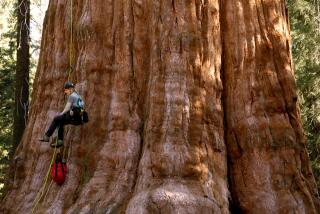Big, old trees keep growing and capturing carbon, study finds
- Share via
Scientists who gathered decades of measurements from hundreds of thousands of trees all over the world are punching a hole in the common assumption that large, old trees are biologically pretty much over the hill.
To the contrary, researchers found that the senior trees have rapid growth rates and keep capturing carbon – lots of it.
“The growth rate just keeps increasing as trees get bigger,” said study leader Nate Stephenson, a California-based research ecologist with the U.S. Geological Survey.
The findings, published Wednesday in a letter in the journal Nature, are based on repeated measurements of 673,046 trees belonging to 403 species across every forested continent.
The 38 authors said that extraordinary growth was not limited to a few standout species, like giant sequoias. “Rather, rapid growth in giant trees is the global norm and can exceed [1,300 pounds] per year in the largest individuals,” they wrote.
The productivity of individual leaves – that is, the amount of mass a tree adds per unit of leaf area – does decline with age. “But the thing is that old trees have so much more leaf area than a little tree, they more than compensate for that decline in productivity,” Stephenson said.
It’s well known that large trees are good at locking up carbon, preventing it from escaping into the atmosphere and contributing to global warming. But the research suggests that the big guys are not just storing carbon. They are fixing large amounts of it with continued rapid growth, every year adding a little more mass to their trunks, limbs and leaves.
At the high end, the authors said a single big tree can in one year add the same amount of carbon to a forest as is stored in an entire mid-sized tree.
“It’s the equivalent of managing a sports team,” Stephenson said. “You need to know who your star players are. It turns out they’re not the 20-year-olds. They’re the 90-year-olds.”
In old growth plots in the western U.S., the authors said the largest trees comprised 6% of the forest but contributed a third of the annual growth in forest mass.
That does not mean, however, that on a forest level old stands capture more carbon overall than young stands. Young forests are denser, with more trees, and when old trees die, they release carbon back into the atmosphere.
Stephenson and Adrian Das, a USGS coauthor, got the idea for the study after observing rapid growth rates in big trees in Sierra Nevada research plots.
They wanted to know whether the same was true elsewhere. So they put out a call for data.
Researchers from around the world responded, providing diameter measurements that had periodically been taken of the same large trees, in some cases over decades. The measurements were then used to figure increases in the trees’ overall mass.
“We already knew it’s important to conserve old trees for the species that depend on them,” Stephenson said. “I just think this adds a little bit of extra emphasis. Not only do they lock up a lot of carbon, they’re really good at pulling carbon out of the atmosphere.”
bettina.boxall@latimes.com
Twitter: @boxall







